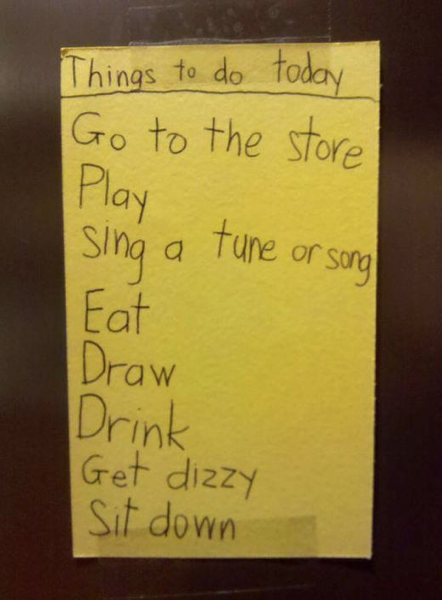 (boingboing.net: A Child’s To-Do List)
(boingboing.net: A Child’s To-Do List)
As Sting said, “There’s too much information / running through my brain. Too much information / driving me insane!” To get the most out of our planning times, we need to tame our to-do lists. But the real goal is getting all this “to-do” out of our heads and into a system that we trust, so that we can focus 100% on our music, and not on whether we’re supposed to pay the electric bill after today’s rehearsal or next week’s…
In my first post on this topic last week, I called them “flies”– all the little distractions buzzing around your head. Let’s tack them on to some industrial-grade flypaper so we can tick them off when the time is right. I use a system called Remember the Milk, which is free and quite powerful, but any online or software-based Task Management system will work. If you have Outlook, for example, you already have one built in! (For much more on this style of organization, please consult David Allen’s Getting Things Done.)
Tags
Most modern task management systems let you use tags to label tasks. A tag is any word (or words) that you might want to use to organize or search your tasks. You can make anything into a tag– you don’t have to use the ones that your program comes with. One of the underlying ideas here is that if you can group tasks together into similar activities, you can make more efficient use of your time without having to transition to totally different activities all of the time. When we’re trying to fit a lot of work into a small planning period, for example, minimizing transitions can save a lot of time.
I like to use tags for three things:
- Type of Activity. Let’s say that I have multiple small edits to make in Finale for different ensembles. If I had all of my tasks organized by ensemble, I’d lose a lot of time waiting for Finale to start up, turning on my keyboard, etc. Instead, I search for all tasks tagged as “Finale” and notice that I have 5 small edits. By doing them all at the same time, I’m taking advantage of both my physical transition (I don’t have to start it up again) and my mental one (I don’t know about you, but it always takes me a few seconds to get my brain into Finale mode).
- Person. If I have things to do for or with other people, or I need to get more information or help from someone, I’ll add their name into a tag. Pulling up all tasks that involve “Bob” lets me make sure that I cover everything that needs to be done when I have Bob on the phone, or when he sticks his head in my office.
- Location. Have you ever walked across campus to the print shop/office/etc. to do something, walked halfway back, and thought “Shoot! I should have done x while I was there!” Tagging tasks with locations helps me remember everything that I have to do in one place before I go.
One nice feature of Remember the Milk is the “tag cloud”– a cluster of tags associated with my tasks. The larger the word, the more it appears. Big words tell me that I need to dedicate some time to a person, project or place.
My tag cloud:
(I need to go visit Everton and Shannon!)
Notes
I attach notes to my tasks as a reminder of what I have to do, beginning steps, or when I last contacted someone about a task. Since notes in RTM are automatically time-stamped, it makes a great communication log. Especially in schools which ask teachers to keep communication logs, having time-stamped notes let you log these contacts automatically.
Notes I wanted to add to a task:
And an example of a communication log:
Deadlines/Reminders
Finally, we get to one of the most obvious advantages of having Task Management software– the possibility of automatic reminders and deadlines. By putting deadlines on your tasks, any software has the capability to notify you through a variety of means. You can have them e-mail you a list of tasks due that day, for example. You could also ask for pop-up notifications on your screen, or to have your tasks appear on your calendars automatically. That way, the note that you wrote yourself several months ago about remembering to register for ACDA National in Dallas this year (you are going, aren’t you?) will come back right when you want it to.
Maximizing Your Valuable Plan Time
By using tags, notes and automatic reminders, you can build a system that you can trust to remind you of the things you used to try and hold in your brain. This can lead to more effective planning time. The bigger goal, though, is to free your mind of your reminders and to-dos during rehearsal so that you can focus on the ensemble before you. Next week we’ll talk about using Smart Lists to organize your ensembles, classes and concerts.
How About You?
Do you use an online/software-based task management system? How do you organize your tasks? What tricks have you found to be useful?


Richard Sparks says